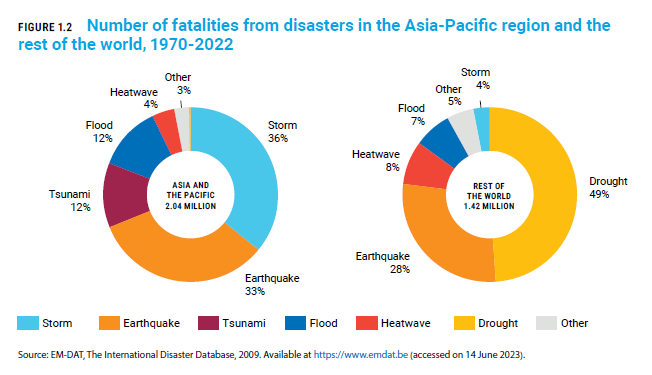UN: Asia-Pacific, region most prone to natural disasters in the world
In 2022 alone, over 140 extreme events were reported. In the last 50 years, disaster-related deaths topped two million, mostly from earthquakes and storms, against 1.42 million in the rest of the world. In a recently released report, the UN Economic and Social Commission for Asia and the Pacific cites last year’s floods in Pakistan, heatwaves in India and drought in Afghanistan to highlight how the region’s poorest countries and South Asia are also the most vulnerable.
Milan (AsiaNews) – Asia-Pacific is the region in the world most prone to natural disasters, this according to a new report from the UN Economic and Social Commission for Asia and the Pacific (ESCSAP).
More than 140 extreme events were reported in 2022 alone, resulting in the death of more than 7,500 people with material losses estimated at US$ 57 billion.
Titled Seizing the Moment, the Asia-Pacific Disaster Report 2023, notes that the window to build adequate climate resilience is narrowing.
If, according to one scenario, temperatures rise by 2 degrees Celsius over pre-industrial levels, droughts, floods, and heat waves (whose intensity and frequency are increasing) will cause, average annual losses of between US$ 924 billion and almost a trillion, or 3 per cent of the region’s gross domestic product (GDP) in a region already at high risk for earthquakes, tsunamis, and volcanic eruptions.
The impact of disaster on people and economies is expected to be uneven across the region, with the least developed countries (Afghanistan, Bangladesh, Bhutan, Nepal, Cambodia, Laos, Myanmar, East Timor, Kiribati, Tuvalu, Solomon Islands) most likely to be affected because of pre-existing vulnerabilities that make it harder to deal with emergencies.
Over the long run, these events will show more clearly the interconnectedness between climate change and poverty, leading to a decline in productivity (especially in agriculture and textile manufacturing) and greater inequalities.
In 2021 and 2022, the deadliest disasters occurred in Afghanistan, a country severely tested and suddenly impoverished after the Taliban seized power again following the pullout of US forces.
The region’s least developed countries recorded mortality rates five to eight times higher than in other states. However, considering the general situation in Asia-Pacific, thanks to improved forecasting and warning systems, deaths dropped in 2020 over previous decades.
More specifically, in its study, the ESCAP looked at natural disasters between 1970 and 2022, noting that Asia-Pacific reported 2.04 million deaths over this period, mainly from earthquakes and storms, against 1.42 million in the rest of the world due mostly to droughts and earthquakes.
Natural disasters affected in some way more than seven billion people in Asia-Pacific, 52 per cent by floods. In the rest of the world, the figure drops to 1.24 billion, with drought the main problem (59 per cent).
With half of the deaths in the last 50 years, South Asia has proven to be one of the most vulnerable subregions.
The impact of climate change was particularly evident in 2021 and 2022. Once again flooding caused the greatest loss of human life (over 4,800 people), in India and Pakistan, followed by Afghanistan, Nepal and Bangladesh.
In Pakistan alone, last summer's devastating floods hit 33 million people (14 per cent of the population), with eight million still displaced at present.
Crop yields in Haryana, Uttar Pradesh, and Punjab dropped by about 10-35 per cent following a prolonged heatwave in March 2022 with temperatures 1.86° Celsius above the long-term average.
The number of deaths caused by extreme heat has yet to be accurately counted, but initial estimates indicate at least 90 deaths in India and Pakistan. In neighbouring Afghanistan, the drought has affected at least 11 million people, 27 per cent of the population.
Earthquakes in Asia caused economic losses estimated at US$ 12 billion, mainly in Japan, China, the Philippines, and Iran.
For the future, the United Nations recommends setting up early warning systems in all countries by 2027 and continued investment in new technologies.
To this end, artificial intelligence and big data "are very important and strategic" for mitigating risks related to natural disasters, explained ESCAP Executive Secretary Armida Alisjahbana, who is from Indonesia.
“A disaster emergency is underway, and we must fundamentally transform our approach to building resilience,” she added.
12/02/2016 15:14
21/08/2020 15:57







.png)










